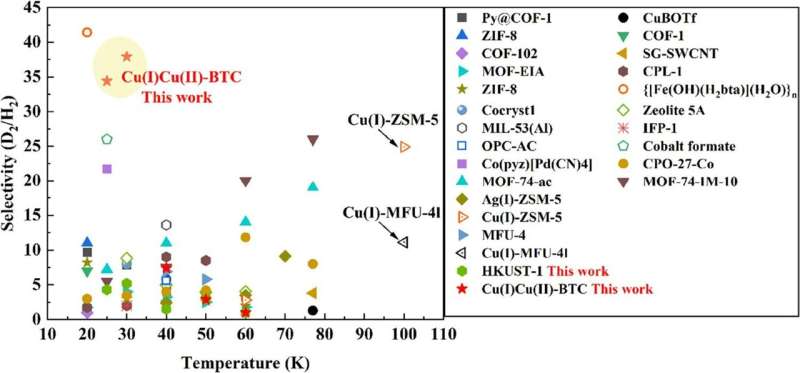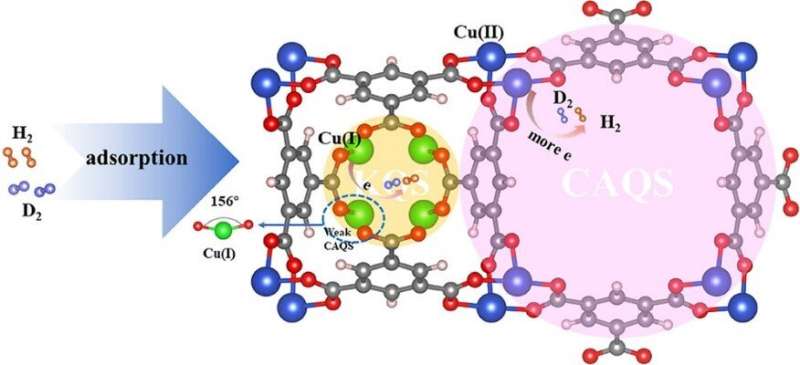This article has been reviewed according to Science X's editorial process and policies. Editors have highlighted the following attributes while ensuring the content's credibility:
fact-checked
peer-reviewed publication
trusted source
proofread
Scientists reveal effect of Cu(I) structure on quantum sieving for hydrogen isotope separation

A research team led by Prof. Chen Changlun from the Hefei Institutes of Physical Science of the Chinese Academy of Sciences has investigated Cu(I)Cu(II)-BTC ((BTC = benzene-1,3,5-tricarboxylate), a type of hydrogen isotope separation material, and demonstrated its crucial role in tuning quantum sieving without a complex structural design, providing a new strategy for the intelligent design of highly efficient isotope systems.
The results were published in ACS Applied Materials & Interfaces.
High purity deuterium (D2) is an important industrial and scientific gas, which has been widely used as an irreplaceable raw material, neutron moderator, isotopic tracer, and in other fields. Despite the huge demand for it, the mole fraction of natural deuterium is only up to 0.0156% of natural hydrogen in the oceans. Moreover, D2 and its isotope (H2 or T2) molecules have almost identical classical dimensions, associated with very similar physicochemical properties, and the separation of hydrogen isotope mixtures in high purity has been considered as one of the greatest difficulties and challenges in modern separation technology.
In this study, HKUST-1 crystals in the presence of hydroquinone were reduced to construct Cu(I)Cu(II)-BTC, featured by dual micropore size distribution and mixed-valence of Cu metal, and were selected to study H2/D2 separation in detail.
The study showed that the unique Cu(I) and Cu(II) coordination network of Cu(I)Cu(II)-BTC could significantly facilitate D2/H2 isotope separation. Density functional theory calculations indicated that the introduction of Cu(I) macrocycles in the framework decreased the pore size and further led to relatively enhanced interaction of H2/D2 molecules on Cu(II) sites. The significantly enhanced selectivity of Cu(I)Cu(II)-BTC at 30 K was mainly attributed to the synergistic effect of kinetic quantum sieving and chemical affinity quantum sieving (CAQS).

In addition, a large angle of 156° for the O-Cu(I)-O configuration in Cu(I)Cu(II)-BTC showed a weak binding strength of hydrogen adsorption since the dz2 orbital and small positive of Cu(I) couldn't effectively participate in the hydrogen interaction, and didn't show a strong CAQS effect at above liquid nitrogen temperature.
This study verifies the effect of Cu(I) structure in D2/H2 separation. "We believe that this study will provide a new strategy for the rational design of porous materials with open metal sites in highly efficient isotope and gas separation systems," said Hu Xiaoyu, first author of the study.
More information: Xiaoyu Hu et al, Highly Effective H2/D2 Separation within the Stable Cu(I)Cu(II)-BTC: The Effect of Cu(I) Structure on Quantum Sieving, ACS Applied Materials & Interfaces (2023). DOI: 10.1021/acsami.2c18221
Journal information: ACS Applied Materials and Interfaces
Provided by Chinese Academy of Sciences





















